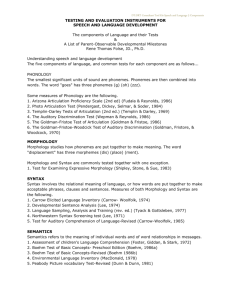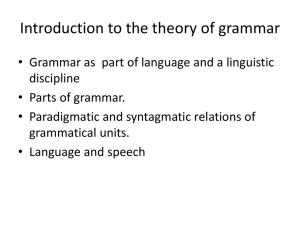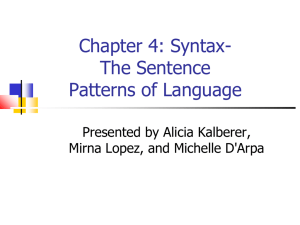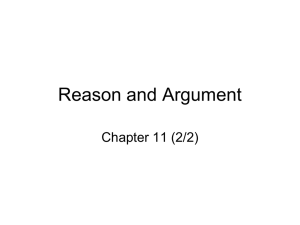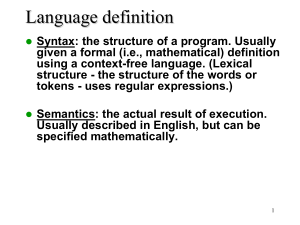Syntax &Semantics
advertisement
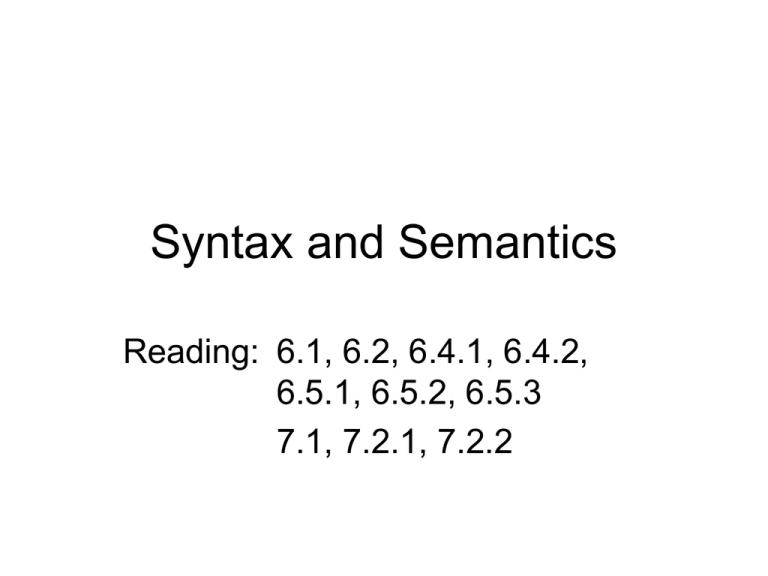
Syntax and Semantics Reading: 6.1, 6.2, 6.4.1, 6.4.2, 6.5.1, 6.5.2, 6.5.3 7.1, 7.2.1, 7.2.2 Syntax • We have seen how language sounds combine to form units of meaning • Syntax studies how such units — words and phrases — participate in meaningful utterances in a language Syntax • One sometimes hears people say that a certain language 'has no grammar', but that is not true of any language. • Every language has about as many grammatical principles — rules for forming utterances — as any other language Syntax • Syntax defined The systematic organizing of the morphology in utterances — by which users of the language can understand each other Principles of Syntax 1. *Word order John hit Bill How do we know who the hitter is? The hittee? Word order Some possible word orders: S V O John kissed Mary : English; Chinese Word order S O V John Mary kissed : Japanese; Korean; Chinese Word order O S V Mary, John kissed : Chinese; English? Word Order V S O kissed John Mary Maori (lg. of indigenous people of New Zealand) Word order • The following Chinese sentence demonstrates principle of word order: wo gaoxing wo de diannao jiu yao dai hui I happy I Poss. PC Gr. will carry back lai le come Gr. I am glad that [I am] getting my PC back Principles of Syntax 2. *Morphological concord (agreement) Marks relations among units in the utterance The dog_ eat_ in the kitchen (how many dogs?) Concord Where do we find concord in this sentence: The girls on the team ran their laps. Concord Notice strong dependence on concord in Spanish: las casas blancas estan bonitas Principles of syntax 3. *morphology (function words, inflections, derivational morphemes, etc.) John hit Bill John kissed Mary What is the time in these? What tells us that? Morphology English: The leadership collected accurate information The morphology participates in this sentence by identifying word class and contributing to the meaning of the words Morphology • How does morphology play a role in the following utterances: They called me names ~ They called my name Morphology Latin depends almost entirely on morphology and concord: Gallia est omnis in partes tres divisa Gall is all in parts three divided All of Gall is divided in three parts Principles of Syntax • English depends on all three of these principles to a varying degree: 1. Word order 2. Concord 3. Morphology Principles of Syntax • Chinese: • 我 自己拿 呀, 我 戴走 可以 的 Wo ziji na ya, wo dai zou keyi de I self take Prt., I carry go ok Prt. I can do it, I will take it my self! particle ya conveys mood, emphatic tone particle de conveys certainty, reassurance word order, with modal particles This use of particles grammaticalizes mood Principles of syntax • Syntax includes *lexical categories. Nouns Verbs Adjectives Adverbs We will define these descriptively Lexical categories • 1. 2. 3. 4. 5. 6. Identity lexical categories by syntactic frames NOUNS: N + pl (-s) dogs N + poss (-s) Tom’s Article + N a dog; the house Article + Adjective +N a big dog N + Relative Clause the dog that barked May be subjects of sentences, objects of Verbs or Prepositions Swimming is fun Lexical categories • Verb frames V + tense wanted; going to eat V + 3 person singular eats Auxiliary + V is eating Adverb + V ran slowly V + Prepositional Phrase ran up the street Lexical categories • Adjectives and adverbs Adj [+ (-er)/more, (-est)/most] + N My car is an older Ford Av [+ (-er)/more, (-est)/most)] + V Of all of us he runs slowest Lexical categories • The result of these lexical categories is phrases that function as constituents of utterances *Constituents • Constituent defined: a word or phrase in an utterance that forms a coherent group Ex. p. 203-4, #1, #2 Identify phrases and constituents Constituents • *Syntactic ambiguity (structural ambiguity) — occurs where a sentence may be understood in two or more ways because of its structure Ambiguity • We need more intelligent teachers Syntactic ambiguity She collects miniature toys and dolls Syntactic ambiguity While growing up his father took him to baseball games Ambiguity • We can use graphic means to demonstrate the ambiguity of sentences • Reed-Kellogg diagrams • Phrase Tree diagrams • Brackets or Looping diagrams Principles of Syntax Colorless green ideas sleep furiously Semantics features • Semantics — the system of meanings in a language Principles of Syntax • The lexicon participates in the syntax because of semantic features of words Semantic features • Words collocate — can be used together — according to their semantic features The child asked for a banana ?The tree asked for a banana *Semantic features • We think of “meaning” as a circle of signification, in which are found semantic features — elements of the meaning. At the heart of the circle is the basic meaning Semantic features • What are the semantic features of pregnant? Semantic features • Pregnant: Animate Vertebrate ? Mammal ? Alive Female Adult ? Big stomach ? Happy ? Married ? morning sickness discomfort and swelling Semantic features • More examples of semantic features: animate ~ inanimate (*a throbbing stone?) human ~ nonhuman (*a very articulate tree?) solid ~ liquid (box ~ bottle) (*a bottle of erasers?) Principles of syntax 1. 2. 3. 4. Word order Morphological concord Morphology Semantic features play a role, in determining what words may be selected for what utterance contexts Exercise 1. What Aerocool can bring you? 2. Emits sweat faster, making you feel cool & comfortable at all the times. 3. Fast dryness guarantees, you could wear right after you wash it. 4. The performance will keep going even after you wash it. (In what ways are these sentences from a product label ungrammatical)

